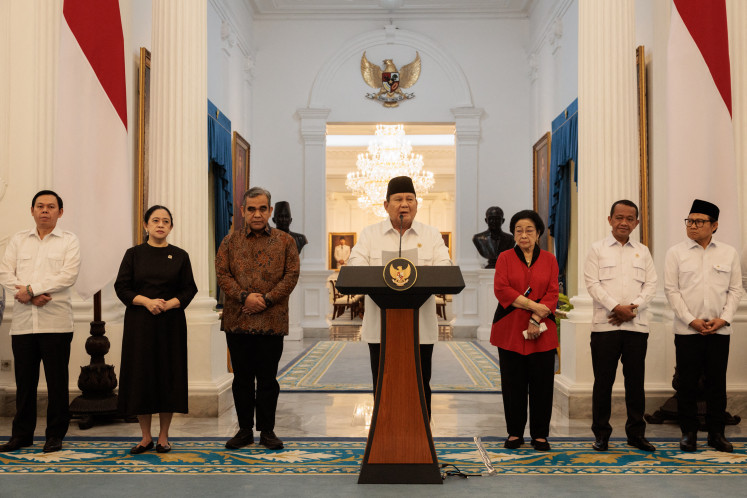Popular Reads
Top Results
Can't find what you're looking for?
View all search resultsPopular Reads
Top Results
Can't find what you're looking for?
View all search resultsA fiscal instrument: The role of automatic stabilizers
Fiscal stabilization involves a response to GDP fluctuations that can be automatic or not. Non-automatic responses include discretionary actions that occur when policymakers take deliberate measures to offset shocks to economic activity.
Change text size
Gift Premium Articles
to Anyone
F
iscal or state budget basically has three functions to the economy: allocating, distributing, and stabilizing. Allocating function is carried out through spending side, while distributing and stabilizing are both conducted through taxes and also spending.
In this article, we will discuss more about the fiscal’s stabilizing function to the economy. Fiscal stabilization involves a response to GDP fluctuations that can be automatic or not. Nonautomatic responses include discretionary actions that occur when policymakers take deliberate measures to offset shocks to economic activity.
Stabilizers include business and personal taxes and such transfers as unemployment benefits, food and housing supports, and other similar social support mechanisms. Because most tax payments by individuals or corporations move in sync with income and spending (progressive), they reduce disposable income during upswings and boost it during slowdowns. Likewise, certain social transfers increase during economic downturns and decrease when growth picks up. Automatic stabilizers play an important role in fiscal stabilization. IMF once reported that the stabilizers often account for more than half of the stabilizing response of fiscal policy in advanced economies. In the case of US, for instance, the size of automatic stabilizers are estimated by the US Congressional Budget Office (2013) to account for US$386 of the $1089 billion deficit in 2012.
Automatic stabilizers help ensure a timely and predictable fiscal reaction that effectively absorbs some of the shocks to disposable income and private expenditure. There is less agreement about whether governments should use discretionary measures beyond automatic stabilizers to limit fluctuations of macroeconomic conditions. The fiscal response of the advanced and emerging economies to the global financial crisis showed the importance of discretionary actions in mitigating the effects on activity of a severe shock. However, it also illustrated one of the limitations of discretionary fiscal measures, namely that “they come too late to fight a standard recession” (Blanchard, Dell’Ariccia, and Mauro 2010).
According to McKay and Reis from London School of Economics, many research have been devoted to measuring the stabilizers such as Auerbach in 2009 and Fedelino, Ivanova, and Horton in 2005. Unlike a quite debatable topic of discretionary fiscal stimulus, these built-in responses of the tax-and-transfer system have been praised over time by many economists as well as policy institutions.
The IMF (Baunsgaard and Symansky, 2009; Spilimbergo, Symansky, Blanchard, and Cottarelli, 2010) recommends that countries enhance the scope of these fiscal tools as a way to reduce macroeconomic volatility. In spite of this enthusiasm, Blanchard (2006) noted that: very little work has been done on automatic stabilization [...] in the last 20 years" and Blanchard, Dell'Ariccia, and Mauro (2010) argued that designing better automatic stabilizers was one of the most promising routes for better macroeconomic policy.
According to the IMF (2015), the dividends of greater fiscal stabilization are especially large in advanced economies, where it could lower output volatility by up to 20 percent. Dividends appear much smaller in emerging market and developing economies, where fiscal stabilization is less effective and is dominated by developmental priorities.
The drawback
The automatic stabilizers widen the budget deficit during the downturns, and vice versa, narrows budget deficit during the upswings. This provides an appropriate fiscal response when an economic shock is driven by demand shock. However, if the economy is hit by a supply shock, offsetting this by the stabilizers will have inflationary consequences - since fiscal stabilizers will boost aggregate demand amid less supply, thus drives up inflation. As Blanchard (2000) shows, with a supply shock, the automatic stabilizers will slow down the convergence to the new potential GDP, hence requiring a fiscal adjustment.
The case of Indonesia
To this day, Indonesia only has the automatic stabilizers in its taxation through progressive income tax. The country’s corporate income tax, however, is no longer progressive since 2010 with single rate of 25 percent. On the spending side, the country does not have automatic stabilizers yet- as typically the case in developing economies.
Unemployment benefit, one of the largest parts of automatic stabilizers and social protection provided in advanced economies -whose adequate fiscal space, relatively small population, and high share public spending as a share of GDP- still needs more time to implement in Indonesia at least within medium term given the country’s limited fiscal space, massive population, and low share of public spending of GDP (19 percent compared to 40 percent OECD average- general government).
Furthermore, social protection spending itself is a big chunk of spending in advanced economies. In 2018 data, on average, it accounts for around 29 percent of OECD countries’ central government outlays. If we take the US as an advanced country that also has massive population (like Indonesia) and provides unemployment benefits, the benefits are generally paid by state governments, funded in large part by states (local government) and federal payroll taxes levied against employers, to workers who have become unemployed not due to their fault.
For Indonesia, local governments are still heavily reliant on central government fiscal transfer that covers around two-third of their budget. Their current aggregate own-source revenue merely stands of 2.4 percent of GDP. As such, this time seems to be not the perfect time yet for Indonesia to provide such benefits. If somehow deemed necessary, though, it should be in limited amount with high conditionality to determine the proper eligibility and avoid moral hazard. If anything, more investments in Indonesian human and physical capital, and other productive outlays to boost the country’s productivity and competitiveness is much more necessary.
In the case of fellow emerging country with huge population, let us see China case. China Labour Bulletin in 2016 reported that the State Councils 1999 Regulations on Unemployment Insurance established a framework for contributions to and payment of unemployment insurance that was largely affirmed by the Social Insurance Law. Both workers and their employers pay into the unemployment insurance system, originally at rates of one and two percent respectively, however many provincial and municipal governments have now substantially cut contribution rates as a means of reducing costs for businesses. In Guangzhou, for example, the employer rate dropped from 1.5 percent to 0.8 percent and the employee rate was cut from 0.5 to 0.2 percent effective 1 May 2016.
At the end of 2015, 173 million workers, including just 42 million rural migrant workers, had unemployment insurance. Those covered are eligible for benefits, including continuation of medical insurance, in the event that they become unemployed. The duration of benefits depends on the length of time the employee has paid into the system, with a maximum of 24 months of benefits for those who have been employed for 10 years or more.
Back to the case of Indonesia, one last point that worth mentioning is that Indonesia also has fiscal rules discipline (most notably capping fiscal deficit to 3 percent GDP) that does not allow the too much fiscal expansion during the bad times, where unemployment benefit and other social transfers work as automatic stabilizers. Such a fiscal discipline, however, still proves to be very effective to make Indonesia’s fiscal soundness intact to this point.
With such good fiscal health condition, when GFC hit the country in 2009 for example, Indonesian government had enough fiscal space to launch fiscal stimulus package to stabilize economy amounted to Rp73.2 Trillion. Furthermore, Government spending on social assistance especially in last 5 years- most notably Family Hope Program (PKH) in the form of conditional cash transfer, National Health Insurance, and food assistance- has been contributing to stabilize the economy by maintaining the people’s purchasing power.
All in all, for the time being, Indonesia’s fiscal stabilizers still rely on discretionary fiscal measures due to its still limited automatic stabilizers. Nonetheless, the country’s fiscal is still doing well in stabilizing the economy, and with good fiscal soundness and progress especially in the last 5 years, the country is still in very good position in fiscal stand point.
***
The writer is an analyst at Fiscal Policy Agency, Finance Ministry. Views in this article are his own.










